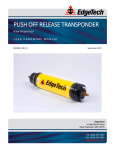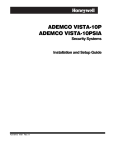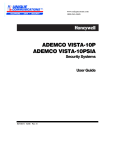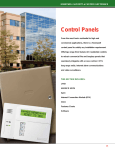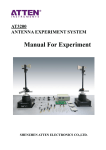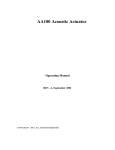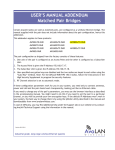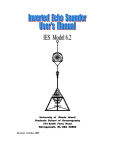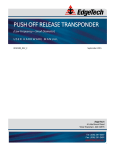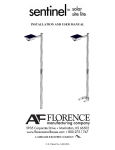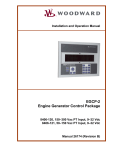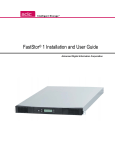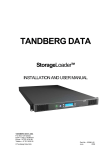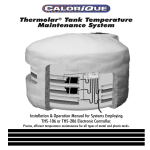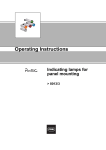Download 8242XS User Manual
Transcript
MODEL 8242XS RELEASE USER HARDWARE MANUAL 0004815_REV_F December 2014 EdgeTech 4 Little Brook Road West Wareham, MA 02576 Tel: (508) 291-0057 Fax: (508) 291-2491 www.EdgeTech.com ii The information, figures, and specifications in this manual are proprietary and are issued in strict confidence on condition that they not be copied, reprinted, or disclosed to a third party, either wholly or in part, without the prior, written consent of EdgeTech. Any reproduction of EdgeTech supplied software or file sharing is strictly prohibited. ©Copyright 2014 by EdgeTech. All rights reserved. MODEL 8242XS RELEASE 0004815_REV_F iii ATTENTION – READ THIS FIRST! All personnel involved with the installation, operation, or maintenance of the equipment described in this manual should read and understand the warnings and recommendations provided below. Static Sensitive Devices This equipment contains devices that are extremely sensitive to static electrical charges. Therefore extreme care should be taken when handling them, as static electricity may be present on the body and clothing. Normal handling precautions involve the use of anti-static protection materials and grounding straps for personnel. Radio Interference This equipment generates, uses, and can radiate radio frequency energy. Therefore if the equipment is not installed properly, it may cause interference with radio communications. The equipment has not been tested for compliance with the appropriate FCC rules designed to provide reasonable protection against such interference when operated in a commercial environment. Therefore when operating the equipment in a residential area, the user may be required to take whatever measures are needed and incur any expenses necessary to eliminate interference; it is the user's responsibility to verify that the system complies with the applicable FCC emission limits. High Voltages High Voltage may be present in all parts of the system. Use caution when the electronics are removed from their containers for servicing. Improper Line Voltage Operation with improper line voltage may cause serious damage to the equipment. Always ensure that the proper line voltage is used. iv HARDWARE VARIATIONS AND COMPATIBILITY The Model 8242-XS Release contains both standard and proprietary hardware. At times EdgeTech may change the standard components due to their availability or performance improvements. Although the component manufacturers, along with their models and styles may change from unit to unit, replacement components will generally be interchangeable. EdgeTech will make every effort to see that replacement components are interchangeable and use the same software drivers (if applicable). At times, however, direct replacements may not exist. When this happens, EdgeTech will provide the necessary drivers with the replacement part. EdgeTech may also change certain hardware per customer requirements. Therefore, portions of this manual, such as parts lists and test features, are subject to change. These sections should be used for reference only. When changes are made that affect system operation, they will be explicitly noted. Also, some options and features may not be active in the customer’s unit at time of delivery. Upgrades will be made available when these features are implemented. MODEL 8242XS RELEASE 0004815_REV_F v MANUAL PREFACE We, the employees at EdgeTech, would like to thank you for purchasing the 8242XS. At EdgeTech, it is our policy to provide high quality, cost effective products and support services that meet or exceed your requirements. We also strive to deliver them on time and to continuously look for ways to improve them. We take pride in the products we manufacture and want you to be entirely satisfied with your equipment. Purpose of this Manual The purpose of this manual is to provide the user with information on the installation and use of EdgeTech’s 8242XS. Although this manual encompasses the latest operational features of the 8242XS, some features may be periodically upgraded. Therefore the information in this manual is subject to change and should be used for reference only. Summary of Sections This manual is divided into the following sections and appendices: SECTION 1: Overview. Basic outline of the system and its uses. SECTION 2: Specifications. Description of the unit in detail. SECTION 3: Set-up & Activation. Configuring and using the unit. APPENDIX A: Tandem Release. Provides images and parts for this option. vi Warnings, Cautions, and Notes Where applicable, warnings, cautions, and notes are provided in this manual as follows: WARNING! Identifies a potential hazard that could cause personal injury or death to yourself or to others. CAUTION! Identifies a potential hazard that could be damaging to equipment or could result in the loss of data. NOTE: Recommendations or general information that is particular to the material being presented. It may also refer to another part of this manual or to another manual. Liability EdgeTech has made every effort to document the 8242-XS Release in this manual accurately and completely. However, EdgeTech assumes no liability for errors or for any damages that result from the use of this manual or the equipment it documents. EdgeTech reserves the right to upgrade features of this software and to make changes to this manual without notice at any time. MODEL 8242XS RELEASE 0004815_REV_F vii WARRANTY STATEMENT All equipment manufactured by EdgeTech is warranted against defective components and workmanship for a period of one year after shipment. Warranty repair will be done by EdgeTech free of charge. Shipping costs are to be borne by the customer. Malfunction due to improper use is not covered in the warranty, and EdgeTech disclaims any liability for consequential damage resulting from defects in the performance of the equipment. No product is warranted as being fit for a particular purpose, and there is no warranty of merchantability. This warranty applies only if: i. The items are used solely under the operating conditions and in the manner recommended in Seller's instruction manual, specifications, or other literature. ii. The items have not been misused or abused in any manner, nor have repairs been attempted thereon without the approval of EdgeTech Customer Service. iii. Written notice of the failure within the warranty period is forwarded to Seller and the directions received for properly identifying items returned under warranty are followed. iv. The return notice authorizes Seller to examine and disassemble returned products to the extent Seller deems necessary to ascertain the cause for failure. The warranties expressed herein are exclusive. There are no other warranties, either expressed or implied, beyond those set forth herein, and Seller does not assume any other obligation or liability in connection with the sale or use of said products. Any product or service repaired under this warranty shall be warranted for the remaining portion of the original warranty period only. Equipment not manufactured by EdgeTech is supported only to the extent of the original manufacturer's warranties. viii RETURNED MATERIAL AUTHORIZATION Prior to returning any equipment to EdgeTech, a Returned Material Authorization (RMA) number must be obtained. The RMA will help us identify your equipment when it arrives at our receiving dock and track the equipment while it is at our facility. The material should be shipped to the address provided in the EdgeTech Customer Service section. Please refer to the RMA number on all documents and correspondences as well. All returned materials must be shipped prepaid. Freight collect shipments will not be accepted. EdgeTech will pay freight charges on materials going back to the customer after they have been evaluated and/or repaired. CAUTION! Never attempt to ship portable topside units in their Storm Case alone. Although rugged, these cases are not intended to be used as shipping containers, and the delicate internal components could be damaged if used in this manner. The following steps apply only to material being returned from outside the Continental United States. Follow them carefully to prevent delays and additional costs. 1. All shipments must be accompanied by three copies of your proforma invoice, showing the value of the material and the reason for its return. If the reason is for repair, it must be clearly stated in order to move through customs quickly and without duties being charged. Whenever possible, please send copies of original export shipping documents with the consignment. 2. If the value of the equipment is over $1000, the following Shipper's oath must be sent with the invoice. This oath can be typed on the invoice, or on a separate letterhead: "I, ______________________________, declare that the articles herein specified are the growth, produce, or manufacture of the United States; that they were exported from the United States from the port of _____________________, on or about _______________; that they are returned without having been advanced in value or improved in condition by any process of manufacture or any other means; and that no drawback, or allowance has been paid or admitted hereof." Signed ______________________________ MODEL 8242XS RELEASE 0004815_REV_F ix 3. If there is more than one item per consignment, a packing list must accompany the shipment. It is acceptable to combine the proforma invoice and packing list as long as the contents of each carton are clearly numbered and identified on the invoice. 4. Small items can be shipped prepaid directly to EdgeTech by FedEx, DHL, UPS, Airborne, etc. 5. If the equipment is the property of EdgeTech (formerly EG&G Marine Instruments Division), please insure for full value. 6. Fax one invoice, packing list, and a copy of the airway bill to EdgeTech upon shipment. x CUSTOMER SERVICE Customer service personnel at EdgeTech are always eager to hear from users of our products. Your feedback is welcome, and is a valuable source of information which we use to continually improve these products. Therefore we encourage you to contact EdgeTech Customer Service to offer any suggestions or to request technical support: NOTE: Please have your system Serial Number available when contacting Customer Service. E-mail: [email protected] Mail: 4 Little Brook Road West Wareham, MA 02576 Telephone: (508) 291-0057 Facsimile: (508) 291-2491 24-Hour Emergency Technical Support Line: (508) 942-8043 For more information please go to www.EdgeTech.com. MODEL 8242XS RELEASE 0004815_REV_F xi COMPANY BACKGROUND EdgeTech (formerly EG&G Marine Instruments) traces its history in underwater data acquisition and processing back to 1966. EdgeTech has designed, developed and manufactured products, instruments and systems for the acquisition of underwater data, including marine, estuarine, and coastal applications for over 45 years. The company has responded to the needs of the scientific, Naval and, Offshore communities by providing equipment, such as sub-bottom profilers, side scan sonar, acoustic releases, USBL positioning systems and bathymetric systems that have become standards in the industry. EdgeTech has also consistently anticipated and responded to future needs through an active research and development program. Current efforts are focused on the application of cutting edge CHIRP and acoustic technology. xii TABLE OF CONTENTS ATTENTION – READ THIS FIRST! ......................................................................................................... iii Static Sensitive Devices ............................................................................................................................ iii Radio Interference ................................................................................................................................... iii High Voltages ........................................................................................................................................... iii Improper Line Voltage ............................................................................................................................. iii HARDWARE VARIATIONS AND COMPATIBILITY .................................................................................. iv MANUAL PREFACE ............................................................................................................................. v Purpose of this Manual ............................................................................................................................. v Summary of Sections ................................................................................................................................ v Warnings, Cautions, and Notes................................................................................................................ vi Liability ..................................................................................................................................................... vi WARRANTY STATEMENT .................................................................................................................. vii RETURNED MATERIAL AUTHORIZATION .......................................................................................... viii CUSTOMER SERVICE ........................................................................................................................... x COMPANY BACKGROUND ................................................................................................................. xi TABLE OF CONTENTS ........................................................................................................................ xii LIST OF FIGURES.............................................................................................................................. xiv SECTION 1: OVERVIEW ..................................................................................................................1-1 SECTION 2: SPECIFICATIONS ..........................................................................................................2-1 2.1 Mechanical .................................................................................................................................... 2-1 2.2 Commands .................................................................................................................................... 2-1 2.3 Transponder .................................................................................................................................. 2-2 2.4 Environmental............................................................................................................................... 2-3 SECTION 3: SETUP AND ACTIVATION ..............................................................................................3-1 3.1 Housing and Release Preparation and Care ................................................................................. 3-1 3.1.1 Disassembly .......................................................................................................................... 3-1 3.1.2 Assembly ............................................................................................................................... 3-3 3.1.2.1 Clevis End Cap Assembly ............................................................................................ 3-3 3.1.2.2 Top End Cap Assembly ............................................................................................... 3-7 MODEL 8242XS RELEASE 0004815_REV_F xiii 3.2 Leak Detection and Condensation Prevention ............................................................................. 3-8 3.3 Arming the Instrument ................................................................................................................. 3-8 3.4 Release Function ......................................................................................................................... 3-10 3.4.1 Release Latch Inspection (following high load in-air releases): .......................................... 3-10 3.5 ON/OFF Option ........................................................................................................................... 3-10 3.6 Air Acoustic Tests ........................................................................................................................ 3-12 3.7 Status Reply ................................................................................................................................ 3-13 3.8 Battery Replacement .................................................................................................................. 3-13 3.8.1 Battery Replacement Considerations ................................................................................. 3-13 APPENDIX A: TANDEM RELEASE ................................................................................................... A-1 xiv LIST OF FIGURES Figure 3-1: Disassembly Diagram ............................................................................................................... 3-2 Figure 3-2: Pressure Housing ..................................................................................................................... 3-3 Figure 3-3: Clevis End Cap Assembly Diagram ........................................................................................... 3-4 Figure 3-4: O-Rings in Clevis End Cap......................................................................................................... 3-5 Figure 3-5: Clamping Hardware ................................................................................................................. 3-6 Figure 3-6: Load Capacity ........................................................................................................................... 3-7 Figure 3-7: Rotation ................................................................................................................................... 3-9 Figure 3-8: Purge Port .............................................................................................................................. 3-11 Figure 3-9: ON/OFF Port Plug................................................................................................................... 3-12 Figure A-1: Tandem Release Shackles and Ring ........................................................................................ A-1 Figure A-2: Top View ................................................................................................................................. A-2 Figure A-3: Bottom View ........................................................................................................................... A-2 MODEL 8242XS RELEASE 0004815_REV_F 1-1 SECTION 1: OVERVIEW This manual describes the EdgeTech Model 8242XS Acoustic Transponder Releases. The Model 8242XS Acoustic Transponder Releases uses EdgeTech’s Binary Acoustic Command System (BACS) and to operate require either the Model 8011, 8011A, AMD200R or PACS acoustic deck units. The Model 8242XS can be used to release oceanographic moorings or can be used for long baseline transponder navigation. In addition to these typical applications there are a number of specialized uses for these Systems, such as opening and closing valves in underwater systems and as emergency recovery systems. The Binary Acoustic Command System (BACS) provides 12,000 possible command codes. The releases have an enable/disable command for controlling the transponder function as a standard feature. When disabled the transponder will not reply when interrogated. The Release command causes the Model 8242XS to disconnect manually from its mooring. The release command can be sent and will cause a release whether the system is enabled or disabled. The enable and disable function only controls the transponder section. WARNING! Applying power to the instrument while it is mechanically loaded may result in release of load and cause serious personal injury. WARNING! When the instrument has a tensile load, careless handling may endanger the user’s hands. Exercise extreme caution to prevent serious personal injury. 2-1 SECTION 2: SPECIFICATIONS 2.1 Mechanical Mechanical specifications for the 8348XS are as follows: Static Load to Failure (tested): 20,000 lbf. (9072 Kg.) Recommended Max Static Load (working): 12,000 lbf. (5443 Kg.) Design Max Release Capability: 10,000 lbf. (5443 Kg.) Recommended Max Release Requirement: 8,000 lbf. (3629 Kg.) Depth Rating (working): 19600 ft. (6000 m.) Collapse Pressure (tested): 26240 ft. (8000 m.) Housing O.D.: 5.12 in. (13 cm.) Housing I. D.: 4.0 in. (10 cm.) Overall Length: 37.0 in. (94 cm.) Housing Length: 20.0 in. (51 cm.) Weight in Air: 80 lb. (36 Kg.) Weight in Water: 61 lb. (28 Kg.) Material: Castings: Wrought: Fasteners Release Type: Ni Al Bronze ASM 48 C95800 - Mil-B-24480 Ni Al Bronze ASTM B150 C63200 - Mil-B-24059 Titanium Spring driven rotary release of compounded levers which can be rearmed externally. 2.2 Commands Command specifications for the unit are as follows: Sensitivity: 80 dB re 1 uPa SNR: > or = 36 dB re root Hz Receiver type: Hard-limited (2000 Hz/330 Hz Bandwidths) 2-2 SECTION 2: SPECIFICATIONS Coding: Allowed Tone Pairs: General to 8000 series – Binary FSK Six PAIR NO 1 2 3 4 5 6 “0” 9.5 kHz 9.5 9.5 9.9 9.9 10.3 “1” 9.9 kHz 10.3 10.7 10.3 10.7 10.7 Structure: Two successive 8 bit words with a 5 sec. interval between them. Each word comprised of 8 bits from a 16 bit command. The 16 bit command is a 15, 11 block cyclic code with an overall parity bit appended to the end to form a 16, 11 code with a minimum Hamming distance of 4 bits. Additionally, two transitions are required within each word, and no repetitions of words are allowed in a command. Pulse Width: 22 mSec. Period: 250 mSec. Total Command Time: 9 Sec. Total Lockout Time: 14 Sec. re Beginning Total Command Capacity per Tone Pair: 2000 or 12000 commands for six tone pairs Standard Functions: Release, Disable Transponder Transponder, Enable 2.3 Transponder Transponder specifications for the 8242XS are listed below: Sensitivity: - 80 dB re 1 uPa. SNR: > or = 44 dB re root Hz for jitter < +/- 0.5 mSec. (3 Sigman). Jitter =+/- 0.1 mSec. for noise-free field. MODEL 8242XS RELEASE 0004815_REV_F 2-3 Interrogate Frequency: 11 kHz (Standard) Post-Filter Bandwidth: 330 Hz. Minimum Interrogate Pulse Width: 5 mSec. Reply Frequency: Default 12 kHz (switch selectable) Reply Source Level: 190 dB re 1 uPa. @ m. Reply Pulse Width: 10 mSec standard Turnaround Time Delay: 12.5 mSec Standard Lockout Time: 1.0 Sec 2.4 Environmental The environmental specifications for the unit are: Temperature: -10 deg. C to +40 deg. C (operating) -20 deg. C to +85 deg. C (storage) 3-1 SECTION 3: SETUP AND ACTIVATION This section contains the information relative to the basic set up and operation of the Model 8242XS acoustic release. The user is referred to the specific information sheet that shipped with the unit, for details of his specific equipment. This sheet includes commands, and transponder frequencies for the particular release. WARNING! When the instrument has a tensile load, careless handling may endanger the user’s hands. Exercise extreme caution to prevent serious personal injury. 3.1 Housing and Release Preparation and Care Access to any portion of the electronics or mechanical assemblies is achieved simply by removing the total of five sets of titanium hardware holding the upper and clevis end caps in place. See Figure 3-1 and Figure 3-2. The internal pressure of the unit is not atmospheric. The 8242XS releases are shipped with 10PSIA (-5PSI gage) of dry nitrogen. This reduces moisture in the housing and helps to seat the O-rings. Equalization of pressure by removal of the purge port plug will be necessary to gain entry into the instrument. WARNING! If the underwater unit has been deployed, there is the possibility of leakage and internal pressurization of the housing. If the housing is pressurized, be sure to exercise extreme caution when relieving the pressure. The resulting violent motion of some parts can result in serious personal injury. 3.1.1 Disassembly Equalize pressure by removing the purge port plug. Remove the three titanium bolts from the top cageclamp assembly. With a soft mallet, tap the cages free of the end cap (two 1/2-inch diameter spreader rods are loose and will fall free of the cage as it is disassembled). Draw the transducer end cap out of the housing. 3-2 SECTION 3: SETUP & ACTIVATION Disable the power supply by disconnecting the connector from the battery pack to the main board. Then disconnect the transducer cable. Remove the two titanium bolts from the lower clamp assembly. With a soft mallet, tap the clamps free of the end cap. Carefully slide the release electronics assembly out of the housing. Take care not to scratch the O-ring surfaces. See Figure 3-3. Figure 3-1: Disassembly Diagram NOTE: In some releases the cable from the electronics to the transducer is short (12 inches (30 cm.)). To prevent parting the cable, always remove the top (transducer) end cap first, and disconnect the transducer from the electronics. MODEL 8242XS RELEASE 0004815_REV_F 3-3 WARNING! High voltage is present at this connector when the unit transmits reply bursts. CAUTION! The ends of the housing are O-ring seating surfaces. They must be protected while the unit is disassembled. Any scratches will impair the performance of the O-rings and may result in leaks. Figure 3-2: Pressure Housing 3.1.2 Assembly The following sub-sections explain how to properly assemble the Clevis End Cap and Top End Cap respectively: 3.1.2.1 Clevis End Cap Assembly Prepare the sealing surfaces for assembly by cleaning with a lint-free towel or swab, moistened if needed with alcohol. Inspect for scratches or nicks which will impair the O-ring efficiency. Apply a Very light coat of O-ring lubricant (i.e., Dow Corning 4 Compound) to the piston surface to aid sliding insertion of the piston seal. Inspect the O-rings for damage or manufacturing flaws such as tears, dimples or inclusions in the rubber. Lightly coat the O-rings with O-ring lubricant. Protect O-rings when stretching them over large diameters (i.e., cover diameter. with plastic sleeve). See Figure 3-4, Figure 3-5, and Figure 3-6. 3-4 SECTION 3: SETUP & ACTIVATION Figure 3-3: Clevis End Cap Assembly Diagram CAUTION! Excess lubricant between seals may cause excessive hydraulic pressure between O-rings and result in improper seating. A light coating is all that is required. MODEL 8242XS RELEASE 0004815_REV_F 3-5 Figure 3-4: O-Rings in Clevis End Cap Slip the electronics into the housing. After the electronics is in the housing and before the transducer end cap is inserted, connect the transducer cable and then the battery. CAUTION! Do not pinch or damage wires when inserting assembly into the housing. There are large diameter plates in the electronics assembly which will not allow clearance for cables or connectors. 3-6 SECTION 3: SETUP & ACTIVATION Carefully press the piston seal into the housing. The backup O-ring is properly aligned if it enters the housing before the O-ring while the curved side of the backup ring faces the O-ring. When the end cap flange mates against the housing, be sure the O-ring is properly seated in the groove and is not crushed outside the groove between the end cap and housing. The end cap is secured to the housing by gently starting one of the clamps onto the 15-degree tapered flanges. After both sides of the clamp have been started, seat the clamp with progressively sharper taps using a soft mallet. The clamping hardware includes 5/16” titanium nuts, bolts and washers. See Figure 3-7. NOTE: Also included are nylon shoulder washers which are essential and must be positioned between the titanium and bronze to prevent damaging galvanic corrosion of the bronze, as shown in the diagram below. Figure 3-5: Clamping Hardware Continue tapping all parts of both clamps with the soft mallet until no further tightening of the hardware is possible. Use a torque wrench if available and torque all five of the titanium fasteners to between 175 and 200 in. lbs. (200-230 centimeter kilograms). MODEL 8242XS RELEASE 0004815_REV_F 3-7 3.1.2.2 Top End Cap Assembly Observe the same O-ring preparation procedures as for the clevis end cap. Connect the transducer lead. Connect battery pack connector to the main board. Clamp the top end cap cage assembly onto the housing, using the same technique with the soft mallet as was used for the clevis end cap. Include both of the ½ inch spreaders when assembling the cage. See Figure 3-7. CAUTION! The instrument’s load capacity is less than 1/10 the rated load if the two 1/2 in. (1.27 cm.) diameter x 4 in. (10 cm.) spreaders are not included in the cage. The horizontal members of the cage must form a complete “box” and not just two parallel sides as shown in the following diagram. Figure 3-6: Load Capacity If the user elects to perform an air acoustic test, it should be performed at this point, before purging. It is advisable to perform an air acoustic test before purging. 3-8 SECTION 3: SETUP & ACTIVATION CAUTION! Do not exceed -5 PSIG while purging the housing. An excess vacuum can damage batteries. 3.2 Leak Detection and Condensation Prevention EDGETECH 8242XS releases are provided with a 3/8-inch diameter purging port in the bottom end cap. The recommended procedure for preparation of the instrument atmosphere is as follows: After checking that all other ports are sealed, draw a near -3 PSIG vacuum via the purging port. Verify with a gauge that the release holds the vacuum. Backfill with dry nitrogen then draw a near -3 PSIG vacuum. Quickly insert the purging plug before the -3 PSIG vacuum is lost. If the environment where the release was assembled was very humid then repeat the purging procedure 2 to 4 times before replacing the plug, to remove all moisture. 3.3 Arming the Instrument The release mechanism is easily armed using only the slotted arming tool that is provided with the system. See figure 9. No disassembly is required even after multiple firings (except for battery replacement). The external moving components of the release mechanism include the following: Primary release hook Slotted release latch T-shaped release shaft The instrument is easily armed by: Capturing the anchor link in the hook, Capturing the end of the hook behind the latch while passing the slot in the latch down over the shaft, rotating the shaft (using the arming wrench) until the internal mechanism “clicks” and holds position DO NOT FORCE THE MECHANISM FURTHER THAN NEEDED (approximately 40 inch pounds torque is required to rotate the shaft 30 degrees clockwise). MODEL 8242XS RELEASE 0004815_REV_F 3-9 CAUTION! Following rotation of the shaft the release mechanism is armed. Do not attempt reverse rotation with the arming tool. Forced reverse rotation will jeopardize optimum performance. Figure 3-7: Rotation The Model 8242XS release is designed to be used with a standard 5/8 inch shackle (maximum .77 inch (1.9 cm.) pin diameter and minimum 1.06 inch (2.7 cm.) opening). NOTE: It is essential that the nickel-aluminum bronze material be isolated from any dissimilar metal. Because of this, the instrument is supplied with a disposable anchor link with nylon insulating bushings. This link or its equivalent must be used to prevent harmful galvanic corrosion between dissimilar metals. 3-10 SECTION 3: SETUP & ACTIVATION 3.4 Release Function After the command to release has been decoded, the power supply is switched on to the motor. The internal torsion spring is released by the motor and provides torque to the t-shaped release shaft. When the t-shaped end of the shaft turns and aligns with the slot in the latch, a release will occur. The shaft carries the mooring tension along its axis with support via two thrust washers at the top (inside end) of the shaft. The torque created by the spring needs to overcome the friction between the shaft and the latch. Because the torque generated by the spring is a fixed quantity, the electrical current requirement of the motor is purely a function of the size of the spring. The central design parameter of the mechanical release assembly is the size (magnitude) of the spring force. The effective battery life is based on the minimum voltage required to release the spring and the maximum release capability is defined by the mooring tension frictional force that the spring must overcome. 3.4.1 Release Latch Inspection (following high load in-air releases): It should be routine practice after any release (air or water) to inspect the release latch and release latch pin for flatness. In the absence of the damping effect of water or if very high loads are released, the hook latch and release link exhibits significant dynamics. When testing the release in air, the hook and latch will strike one another. Slight bending of the latch or latch pin (a few thousandths of an inch) may occur. Bending greater than .002-inch in the latch or pin will impair the release performance and may warrant replacement of the bent part. To prevent binding during in-air tests, bond a 3/8-inch thick by 2-inch long strip of rubber to the hook. This will absorb the shock of impact when the latch strikes the hook. This is only necessary if a heavy load will be used for the test. 3.5 ON/OFF Option When the On/Off Option is included, the instrument may be fully prepared and sealed before powering the electronics. The power supply is an open loop until the on/off port plug is fully inserted. The on/off port plug is a keyed four-pin plug that closes the power supply circuit when it engages the connector inside the instrument. Proper alignment of the plug is with the 1/8-inch milled slot in the top of the plug pointed away from the center of the end cap. See Figure 3-8. Note the plug is approximately flush with the end cap when the instrument is powered on (and the glass epoxy retainer is wrapped around the .19-inch diameter stub.) See Figure 3-9. MODEL 8242XS RELEASE 0004815_REV_F 3-11 Figure 3-8: Purge Port 3-12 SECTION 3: SETUP & ACTIVATION Figure 3-9: ON/OFF Port Plug 3.6 Air Acoustic Tests Always perform an air acoustic test of the commands and interrogate the instrument after assembling to assure proper working order. Every time the instrument is powered up, repeat the air acoustic test to assure proper engagement of the On/Off plug. Place the speaker or transducer about 6 to 12 inches from the underwater unit transducer when sending commands. The position of the transducers relative to one another may need to be adjusted to allow commands to get through in air. Ranges will not be MODEL 8242XS RELEASE 0004815_REV_F 3-13 accurate in air; these systems are designed to operate in water. The speed of sound in air can cause errors in command decoding and prevents accurate ranging however the systems can be tested in air. Test all functions of the system by sending each command and verifying that the state changed according to the command including status reply. 3.7 Status Reply Upon receiving a valid command the instrument will return a series of pings which are an indication of the status of the tilt and release sense switches. The 4 possible status replies are: Upright and Not released: 15 pings at a 2 second rate. Tilted and Not released: 7 pings at a 2 second rate. Upright and released: 15 pings at a 1 second rate. Tilted and released: 7 pings at a 1 second rate. 3.8 Battery Replacement Remove the electronics chassis from the housing according to the disassembly procedure. Make sure that the battery connector is disconnected from the board and remove the brackets which hold the battery pack to the aluminum plate. Discard the old battery. Install the new battery and replace the brackets which hold it in. Route the battery connection in such a way that it will not be crushed when assembling the electronics in to the housing. After replacing the batteries, the user is advised to perform an air acoustic check of the release. Assemble the electronic chassis in the release housing. 3.8.1 Battery Replacement Considerations These releases are high performance instruments and it is presumed that they are employed to recover high value oceanographic instruments and data. For this reason extreme care must be exercised in choosing replacement batteries. EdgeTech makes considerable effort to test various batteries and to provide control of the manufacture of replacement batteries for its equipment. The user should exercise extreme care in selecting replacement battery packs. The particular manufacturer's cell discharge characteristics and repeatability should be known. The date of manufacture and the history of shipping and storage should be known if not controlled; batteries should be no more than one year old when placed in service. Cleanliness and careful inspection techniques should be employed when assembling the batteries into welded packs. Careful attention should be paid to purging the unit so as not to leave air or moisture inside before storage or deployment. A-1 APPENDIX A: TANDEM RELEASE This appendix gives the parts for the tandem release option involving two 8242XS releases working to simultaneously release a load: Figure A-1: Tandem Release Shackles and Ring A-2 APPENDIX A: TANDEM RELEASE Figure A-2: Top View Figure A-3: Bottom View MODEL 8242XS RELEASE 0004815_REV_F




































